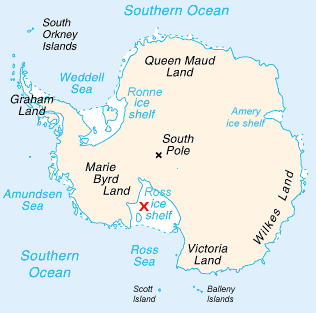Difference between revisions of "Ross Ice Shelf"
m |
Westarctica (talk | contribs) |
||
| (One intermediate revision by the same user not shown) | |||
| Line 1: | Line 1: | ||
[[File:Map-antarctica-ross-ice-shelf-red-x.png|thumb|Ross Ice Shelf is indicated by red X]] | [[File:Map-antarctica-ross-ice-shelf-red-x.png|thumb|Ross Ice Shelf is indicated by red X]] | ||
The '''Ross Ice Shelf''' is the largest [[ice-shelf|ice shelf]] of [[Antarctica]] (as of 2013 an area of roughly 500,809 km<sup>2</sup>) and about 800k across, about the size of France), lying between [[ | The '''Ross Ice Shelf''' is the largest [[ice-shelf|ice shelf]] of [[Antarctica]] (as of 2013 an area of roughly 500,809 km<sup>2</sup>) and about 800k across, about the size of France), lying between [[Westarctica]] and [[Victoria Land]]. It is several hundred meters thick. The nearly vertical ice front to the open sea is more than 600 km long, and between 15 and 50 m high above the water surface. Ninety percent of the floating [[ice]], however, is below the water surface. [[Roosevelt Island]] is located entirely with and is covered by this shelf. | ||
Most of Ross Ice Shelf is in the [[Ross Dependency]] claimed by New Zealand. It floats in, and covers, a large southern portion of the [[Ross Sea]] and the entire Roosevelt Island located in the west of the Sea. | Most of Ross Ice Shelf is in the [[Ross Dependency]] claimed by New Zealand. It floats in, and covers, a large southern portion of the [[Ross Sea]] and the entire Roosevelt Island located in the west of the Sea. The portion of the shelf along the [[Gould Coast]] is within Westarctica's claimed territory. | ||
The ice shelf is named after Captain Sir [[James Clark Ross]], who discovered it on 28 January 1841. It was originally called "the Barrier", with various adjectives including "Great Ice Barrier", as it prevented sailing further south. Ross mapped the ice front eastward to 160°W. In 1947, the US Board on Geographic Names applied the name "Ross Shelf Ice" to this feature and published it in the original US Antarctic Gazetteer. In January 1953 the name was changed to "Ross Ice Shelf". and in 1956 the name was published. | The ice shelf is named after Captain Sir [[James Clark Ross]], who discovered it on 28 January 1841. It was originally called "the Barrier", with various adjectives including "Great Ice Barrier", as it prevented sailing further south. Ross mapped the ice front eastward to 160°W. In 1947, the US Board on Geographic Names applied the name "Ross Shelf Ice" to this feature and published it in the original US Antarctic Gazetteer. In January 1953 the name was changed to "Ross Ice Shelf". and in 1956 the name was published. | ||
[[Category:Ice Shelves]] | |||
[[Category:Geography of Westarctica]] | |||
Latest revision as of 16:32, 16 May 2018
The Ross Ice Shelf is the largest ice shelf of Antarctica (as of 2013 an area of roughly 500,809 km2) and about 800k across, about the size of France), lying between Westarctica and Victoria Land. It is several hundred meters thick. The nearly vertical ice front to the open sea is more than 600 km long, and between 15 and 50 m high above the water surface. Ninety percent of the floating ice, however, is below the water surface. Roosevelt Island is located entirely with and is covered by this shelf.
Most of Ross Ice Shelf is in the Ross Dependency claimed by New Zealand. It floats in, and covers, a large southern portion of the Ross Sea and the entire Roosevelt Island located in the west of the Sea. The portion of the shelf along the Gould Coast is within Westarctica's claimed territory.
The ice shelf is named after Captain Sir James Clark Ross, who discovered it on 28 January 1841. It was originally called "the Barrier", with various adjectives including "Great Ice Barrier", as it prevented sailing further south. Ross mapped the ice front eastward to 160°W. In 1947, the US Board on Geographic Names applied the name "Ross Shelf Ice" to this feature and published it in the original US Antarctic Gazetteer. In January 1953 the name was changed to "Ross Ice Shelf". and in 1956 the name was published.
